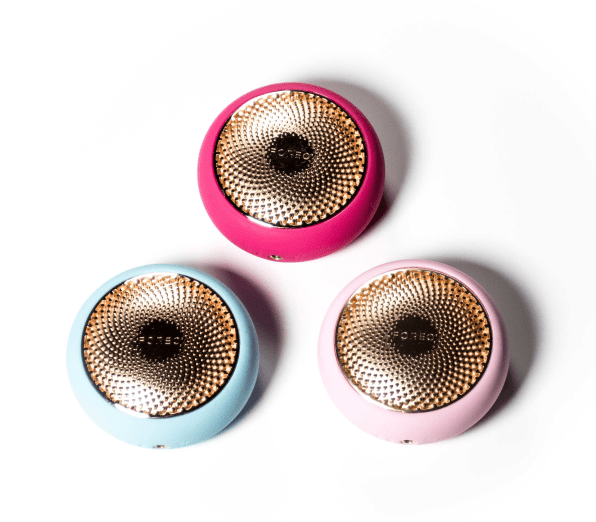Face Mask Of The Future? This Gadget Promises Less Goo, More Tech
“The whole time they feel like they are going to slide off.”
“I wish subscription boxes stopped giving them to me.”
“I hate them.”
These are just some of the (milder) responses I got when I asked my female colleagues at Fast Company to share their thoughts on sheet masks, i.e. single-use facial fabrics doused in serums. Most complained of the time required for the beauty ritual, others balked at the sloppy and complicated application procedure, while one simply replied, “They make me look like a monster.”
Such reviews are not uncommon. Despite being the most googled beauty trend of 2017, the fad leaves a lot to be desired. How does a cold, dripping mess induce relaxation? Why must we lie motionless in hopes that a wet fabric doesn’t fall victim to gravity? They might work at “brightening” and “soothing” your face, but at what cost?
Paul Peros, physicist and CEO of beauty device company Foreo, wants to end the goopy madness. He believes the sheet masks now on the market make it impossible for one to enjoy on a regular basis—relegating them to weekends, flights, and opportunities in which to scare children.
“We need to bring performance, but we need to bring it in an ergonomically acceptable way in terms of delivering something that fits into people’s lifestyles,” says Peros. “[Right now], it requires 20 minutes where one is not able to do anything else.”
Four years ago, Stockholm-based Foreo (which stands for “for everyone”) began to research ways to improve on the sheet mask. At the Consumer Electronics Show (CES) on Monday, the company unveiled the UFO, a handheld gadget that simplifies the experience to just 90 seconds.

Described as “the world’s first smart mask treatment,” the $270 device combines three different light-emitting diode (LED) therapies with cryotherapy, thermotherapy, and T-Sonic pulsations. It comes with circular, serum-soaked sheet masks that perfectly fit the device. (One can technically use any mask of choice, though it would dwarf the electronic, making for a messy scene.) Masks include hyaluronic acid with red algae and olive oil with ginseng and come in packs of three for $12.99.
You simply remove the mask from its packaging, clip it into the rechargeable, donut-shaped device, press start, then glide it across your face as it changes LED every 30 seconds.
Foreo says the red LED offers collagen-boosting benefits, the green LED brightens dull complexions, and the blue induces circulation and kills acne-causing bacteria. It begins with heat to open one’s pores, then ends with cold to lock in the serum’s ingredients. Each treatment incorporates a specific combination of temperature and pulsation intensity.

“[The LED] helps to better absorb the product and to relax and massage you,” explains Peros. “It’s basically like a facial.”
Estheticians have long relied on pulsation and light therapy to target a medley of skin issues. Researchers from Tel Aviv University and Harvard Medical School found that pulsed electric fields can generate new skin tissue growth. And a 2009 study in The Journal of Clinical and Aesthetic Dermatology showed that daily use of blue light therapy significantly reduced the appearance of acne.
Peros says melding all these therapies together in an easy-to-access format can take sheet masks “to a completely new level” in popularity. Facial masks quickly found a following a few years ago during the Korean beauty boom. They have since been adopted by numerous companies, ranging from prestige brands like Estée Lauder to drugstore stalwarts like Neutrogena, and touted by celebrities such as Lady Gaga and Drew Barrymore.
Currently, Sephora sells more than 100 kinds of sheet masks, and a report by Transparency Market Research expects the U.S. sheet-mask market to exhibit a Compound Annual Growth Rate of 8.7%, reaching $336.7 million by 2024.
Foreo envisions gizmo-izing wellness rituals much the same way it did dental care and face cleansing. The company boasts two popular products in the beauty industry: an electric vibrating cleanser brush called the LUNA, and a chic, sonic pulsing toothbrush called the ISSA. Foreo’s catalog is found in over 5,000 stores in more than 40 countries. Since its founding in 2013, the company reports selling more than 10 million products.
“We want to bring true innovation, but we would also like to do so in a fun and engaging way,” says Peros.
I received a prototype of the UFO, with high hopes that it could reignite my interest in sheet masks. As promised, it was a simple procedure: it took mere seconds to secure the sheet, at which point I massaged the beating device around my face as it heated up to a warm, comfortable temperature. It reminded me of my Clarisonic brush, which feels cleansing, firming, and relaxing all at the same time.

In under two minutes, the entire ordeal was over. I could return to whatever it was I was doing before. There was no goo on the floor or sticky fingers to clean. It was so seamless that I voluntarily did all over again the very next day.
“The convenience factor will help grow the mask market overall because if nothing else, it will allow consumption on a daily basis,” says Peros hopefully.
Perhaps, but likely the biggest hurdle is one of cost. At $279, it’s hardly an affordable mass product, considering that most face masks range from $2 to $15. (The brand is conducting a prelaunch phase on Kickstarter in which customers can save up to 50% off.)
Foreo also assumes consumers will heavily invest in what is often considered a secondary beauty ritual (following more traditional skincare products like moisturizer) and that they’d prefer it more often. The company potentially fails to consider that for some, the allure of face masks is less results-oriented: It’s more about the wellness ritual. The exorbitant amount of time they require is precisely the point of the ritual.
Sheet-mask makers, however, are already keen to partner with Foreo’s latest invention. The company says it is in talks with several producers and brands who plan on adapting existing products to the UFO technology platform.
In fact, Peros compares the gizmo to another such gadget that changed the face of its own industry.
“Think back to when the iPhone came out–it combined all the needs in one central point, addressing functionality as well as user-friendliness and ergonomics,” says Peros. “The UFO is the pinnacle of integration, the mosaic of all these functional elements that we have developed over the past few years . . . within 90 seconds.”
Fast Company , Read Full Story
(39)



